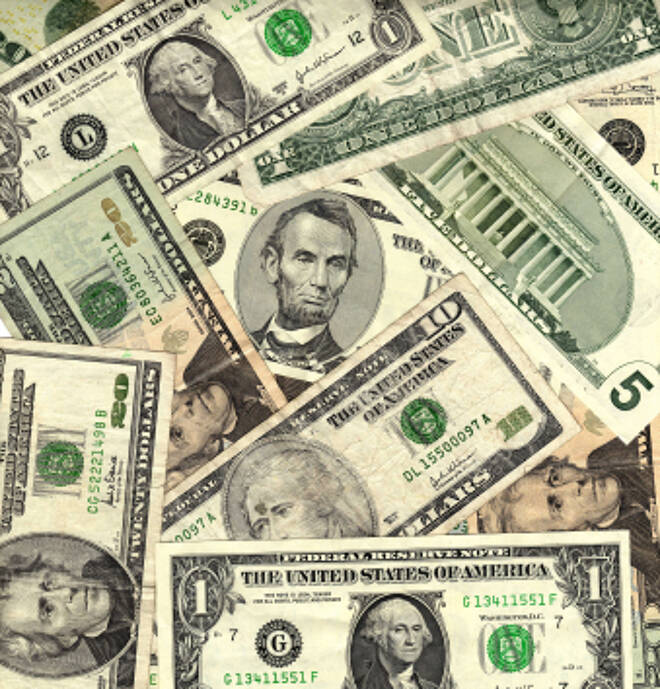Advertisement
Advertisement
Second-Quarter Dollar Direction to be Determined by Jobs and Inflation
By:
The dollar started the year under pressure because investors thought the Fed would turn a little a dovish, while the rest of the major central banks would continue on a path toward higher interest rates. However, as the global economy began to weaken, the major central banks turned dovish.
The U.S. Dollar finished higher against a basket of currencies during the first quarter, surviving three attempts between January and March to break the greenback and continue the weakness that began in early December 2018 and continued into the first week of the new year. The price action was primarily driven by wild swings in Treasury yields and safe-haven buying. The catalysts behind the price action was central bank activity led by the U.S. Federal Reserve and the European Central Bank.
For the quarter, U.S. Dollar Index futures finished at 96.845, up 1.287 or +1.35. Here is how the components of the index faired. The EUR/USD settled at 1.1218, down 0.0250 or -2.18%. The USD/CHF finished at .9951, up 0.0137 or +1.39%. The USD/JPY closed at 110.844, up 1.241 or +1.13%.
The U.S. Dollar lost ground to the British Pound and Canadian Dollar. The GBP/USD settled at 1.3033, 0.0279 or +2.19% and the USD/CAD closed at 1.3351, down 0.0289 or -2.12%.
Price Action
The U.S. Dollar began the year under pressure as economic uncertainty drove investors to speculate the Fed would be forced to soften its tone toward hiking interest rates. The sell-off which began on December 14 at 96.655 lasted until January 10 when the index bottomed at 94.150. This was a drop of 32.505 points in 17 market sessions.
The low at 94.150 turned out to be the low of the quarter. The dollar began its rally from a three-month low after Federal Reserve Chairman Jerome Powell said the central bank intends to further shrink the balance sheet, suggesting it is not done tightening monetary policy yet. The Fed chairman also said he sees no near-term risk of a U.S. recession and expects continued momentum in economic data. However, he reiterated that the Fed can be patient on monetary policy and can move “flexibly and quickly” if economic data warrants it.
The second major rally for the U.S. Dollar Index began on January 31 at 94.380. This rally drove the index to 96.685 on February 15 before sellers pushed it back down to 95.240 on February 28.
This rally was fueled by the strong January jobs report which calmed some recession fears as did a stronger than expected ISM manufacturing report. The jobs report showed the economy added 304,000 jobs in January. Earlier in the week, the Fed had removed a big concern for investors, when its post-meeting statement and Fed Chairman Jerome Powell’s briefing tilted dovish, assuring markets the Fed would pause in its interest rate hiking.
The third rally for the quarter began on March 20 at 95.17 and is likely to continue into April after finishing the quarter on a high note at 96.845.
This rally began when the Fed said it sees no rate hikes in 2019. It also said it plans to slow balance sheet reduction. Furthermore, after the Fed meeting, traders indicated they saw nearly even chances of a Fed rate cut in early 2020.
Second-Quarter Outlook
The first quarter was highlighted by “sell the rumor, buy the fact situations”. In other words, the dollar weakened in anticipation of dovish news from the Fed, and rallied when they delivered what the markets were expecting.
The dollar started the year under pressure because investors thought the Fed would turn a little a dovish, while the rest of the major central banks would continue on a path toward higher interest rates. However, as the global economy began to weaken, the major central banks turned dovish. So when the Fed also turned dovish, the situation was neutralized. Given this change in events and the upside momentum into the end of the first quarter. The dollar index may have the fire power to reach a new multi-month high in the second quarter.
The dollar is likely to weaken against the major currencies if the economy continues to show weakness especially the employment situation and inflation. If these two components weaken then look for talk to surface about a rate cut. This would put pressure on the dollar.
About the Author
James Hyerczykauthor
James Hyerczyk is a U.S. based seasoned technical analyst and educator with over 40 years of experience in market analysis and trading, specializing in chart patterns and price movement. He is the author of two books on technical analysis and has a background in both futures and stock markets.
Advertisement
